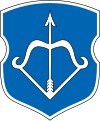Brzesc Litewski
|
Brest Брэст / Брест Brześć |
|||
|---|---|---|---|
 |
|||
|
|||
| Location in Belarus | |||
| Coordinates: 52°08′N 23°40′E / 52.133°N 23.667°ECoordinates: 52°08′N 23°40′E / 52.133°N 23.667°E | |||
| Country |
|
||
| Region | Brest Region | ||
| First mention (Primary Chronicle) | 1019 | ||
| First mention (Novgorod First Chronicle) | 1017 | ||
| Government | |||
| • Chairman of the Brest City Executive Committee | Aleksandr Rogachuk | ||
| • Chairman of the Brest City Council of Deputies | Nikolai Krasovsky | ||
| Area | |||
| • Total | 145 km2 (56 sq mi) | ||
| Elevation | 280.4 m (919.9 ft) | ||
| Population (2016) | |||
| • Total | 340,141 |
||
| Time zone | FET (UTC+3) | ||
| Postal code | 224000 | ||
| Area code(s) | +375 (0)162 | ||
| License plate | 1 | ||
| Website | Official website | ||
Brest (Belarusian: Брэст Brest or traditionally Берасьце, Bieraście; Russian: Брест Brest, Ukrainian: Берестя Berestia, Lithuanian: Lietuvos Brasta, Polish: Brześć) formerly also Brześć nad Bugiem Brest-on-the-Bug and Brest-Litovsk ("Брэст-Лiтоўск" in Belarusian), is a city (population 310,800 in 2010) in Belarus at the border with Poland opposite the Polish city of Terespol, where the Bug and Mukhavets rivers meet. It is the capital city of the Brest voblast.
The city of Brest is a historic site of many cultures. It was the location of important historical events such as the Union of Brest and Treaty of Brest-Litovsk. The Brest Fortress was recognized by the Soviet Union as the Hero Fortress in honor of the defense of Brest Fortress in June 1941.
During medieval times, the city was part of the Kingdom of Poland from 1020 until 1319 when it was taken by the Grand Duchy of Lithuania. It became part of the Polish–Lithuanian Commonwealth in 1569. As a result of the Partitions of Poland, it was incorporated into the Russian Empire in 1795. After World War I, the city returned to Second Polish Republic. During the Invasion of Poland by Nazi Germany and the Soviet Union in 1939 the city was first captured by the Wehrmacht and soon passed on to the USSR in accordance with German–Soviet Frontier Treaty. In 1941 it was taken again by the Nazis during Operation Barbarossa. After the war, once the new boundaries between the USSR and Poland were ratified, the city became part of the Soviet BSSR until the breakup of the country in 1991. It is part of sovereign Belarus of today.
...
Wikipedia



